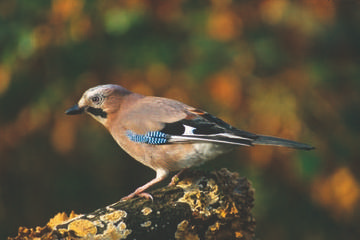
Jay © Simon Booth
This is the corvid of woodland: the habitat codes supplied came mostly from woodland (65% of records), mostly broadleaved or mixed, with 9% in scrub, 17% on farmland and 8% in human sites. Despite their quite restricted needs, Jays have increased their range since our First Atlas, with a net gain of presence in fifty tetrads. The ‘change’ map shows their increase most noticeably along the Mersey valley and in south central Cheshire, and they have particularly moved into urban areas around Widnes, Warrington, Chester and Crewe.
The national breeding population index has fluctuated but with no overall trend, and their numbers are much the same as during our First Atlas. According to the analysis of BBS transects in Cheshire and Wirral, their breeding population in the county in 2004-05 was 5,520 birds (2,470-8,570), an average of 10 birds per tetrad in which they were found.
Their display in April can be entertaining to watch, as several birds often chase each other through the trees, and is a good way of locating territories, but the wary birds usually see the human much quicker than the other way round, and often all that can be detected is a raucous squawk and a flash of white rumps as they fly off. Jays’ nests are difficult to find. They are secretive birds, usually building in dense scrub or small trees, and their nests are surprisingly small, often little bigger than that of a Blackbird. Only in 25 tetrads did observers record a nest as proof of breeding, and most confirmed breeding came from seeing adults carrying food for their chicks (53 tetrads) or with recently-fledged young (91). Amongst the categories of probable breeding, 13 tetrads furnished evidence of birds carrying nesting material, and 11 of Jays visiting a probable nest site.
They forage during the breeding season for invertebrates to feed to their young, especially defoliating caterpillars, beetles and spiders. Jays are well known for predating the eggs and chicks of smaller birds. Parents feed their older chicks some acorns that they have dug up from those stored the previous year, even if they have sprouted and have started to become oak seedlings; Jays seem able to distinguish between the green-stemmed seedlings, newly grown and still palatable, and the brown-stemmed young shoots from previous years, which they ignore (Coombs 1978).
Sponsored by The Arnold Family (Hebe, Clair and Mark)

